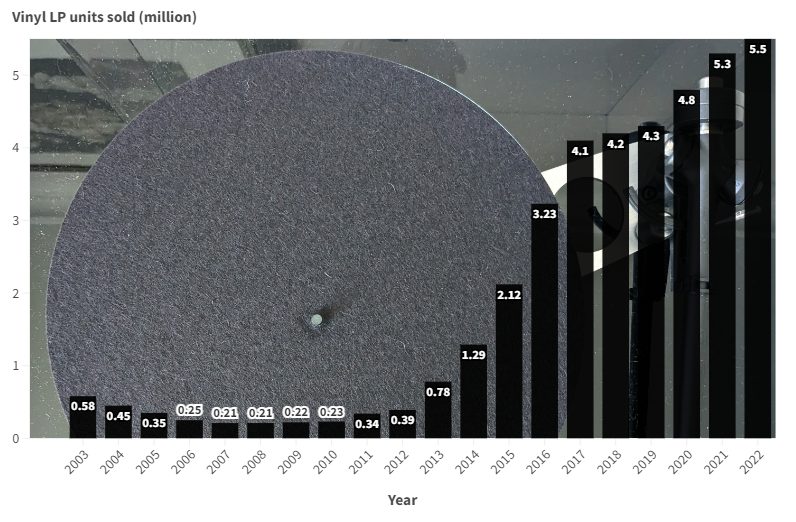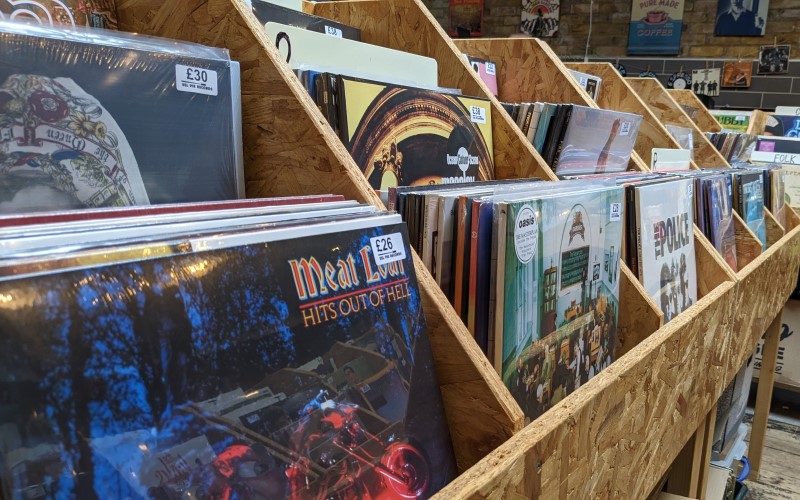It has been well publicised that 2022 was the first time in 35 years that vinyl sales exceeded CDs in the UK, but the caveats are less well known.
The so-called ‘vinyl revival’ began in 2007, since which the number of vinyl albums sold has increased every year, according to figures from the British Phonographic Industry (BPI).
The latest year of that surge saw vinyl sales outstrip CDs’ with £150.5 million-worth of vinyl sold compared to £124 million-worth of CDs.
However, co-owner of Twickenham’s Eel Pie Records, Phil Penman, while delighted with vinyl’s overall growth, believes the recent increase may be overstated.
He said: “There’s a statistical analysis that can be used to make any story, and a good news story is better than a bad news story.
“So, rather than talk about the demise of CDs which is most definitely true, we hear about the growth of vinyl, which is also true, but the year-on-year increases aren’t as dramatic as people are being led to believe.”
This analysis fits with the data, as the headline figure of vinyl sales overtaking CDs is helped by an annual decrease of 17.4% in CD sales, with just an 11% increase in vinyl sales.
Another key thing to remember is how this is measured.
Penman added: “The average value of a record coming out of a record company is probably three times that of a CD.
“So, if the values of sales are level, for example, CDs are still three times as big as vinyl.”
So, despite vinyl outselling CDs in sales terms, only around 5.5 million vinyl LPs were sold in 2022 compared to 11.6 million CDs.

But what cannot be disputed is the growth of vinyl away from CD comparisons, helped by its expanding target market.
“When we opened up this shop six years ago, our initial thought was that customers were very much like myself and my business partner Kevin Jones,” Penman said.
“A lot of 45 to 60-year-olds who are revisiting and reconnecting with something from the past.
“As time has gone by that demographic has gone down, and down, and down. We get a lot of teenagers here, younger people, families. It has definitely changed.
“If you’re an artist that isn’t in the digital space, that is looking at a 16-to-40-year-old age-group, who have some disposable income who buy into going to the gig, wearing the t-shirt, owning something, then it makes a lot of sense to target the vinyl market.
“Also, because charts mean so much to record companies, they love being able to say, ‘no.1 record’, ‘top-10 record’, so it makes a bigger impact if you realise your demographic is more focused on the ownership than just the listening.”
This would appear to be the case for that younger audience as much as their older counterparts.
The UK Official Chart Company’s top 10 vinyl albums of 2022 featured Taylor Swift, Harry Styles, and The 1975, alongside older names such as Fleetwood Mac, Liam Gallagher, and Muse.
Another, perhaps more impressive, element to vinyl’s increasing popularity is its resistance to mounting pressures on people’s finances.
The 15 consecutive years of growth span over the 2009 financial crisis, and Covid pandemic, and the cost of living crisis will once again test this resilience, both of the consumers and the suppliers.
Penman said: “Music is first and foremost a luxury purchase.
“However, in my experience it has been very resilient to recessions and economic pressures.
“People might retreat from going out or spending so much money on eating out, but they won’t give up their music. They’re wedded to their music.
“But the cost-of-living crisis is combined with really high inflation in our own market. The cost of vinyl has rocketed over the past two or three years.
“People are thinking twice about whether they can afford two records or maybe just buying one, so the pressure’s definitely on.”
With that in mind, this year could be the one which puts an end to vinyl’s increased uptake, instead the test will be to see if it can remain at the sustainable level it has increased to.





